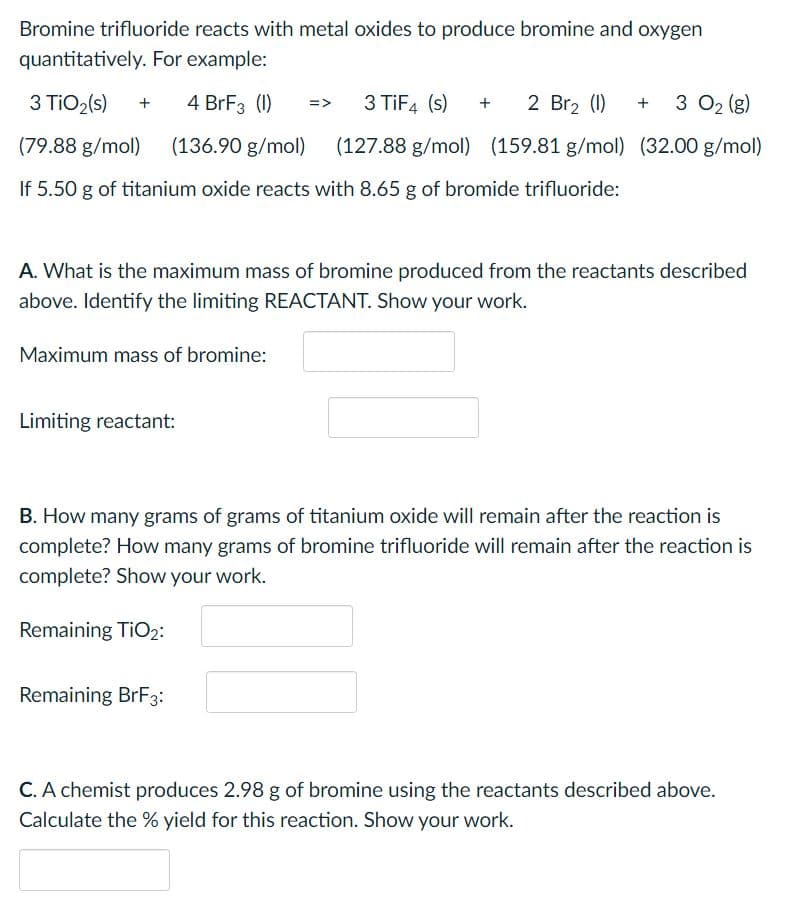Bromine trifluoride reacts with metal oxides to produce bromine and oxygen quantitatively. For example: 3 TIO2(s) 4 BrF3 (1) 3 TİF4 (s) 2 Br2 (1) + 3 02 (g) => (79.88 g/mol) (136.90 g/mol) (127.88 g/mol) (159.81 g/mol) (32.00 g/mol) If 5.50 g of titanium oxide reacts with 8.65 g of bromide trifluoride: A. What is the maximum mass of bromine produced from the reactants described above. Identify the limiting REACTANT. Show your work. Maximum mass of bromine: Limiting reactant: B. How many grams of grams of titanium oxide will remain after the reaction is complete? How many grams of bromine trifluoride will remain after the reaction is complete? Show your work. Remaining TiO2: Remaining BrF3: C. A chemist produces 2.98 g of bromine using the reactants described above. Calculate the % yield for this reaction. Show your work.
Bromine trifluoride reacts with metal oxides to produce bromine and oxygen quantitatively. For example: 3 TIO2(s) 4 BrF3 (1) 3 TİF4 (s) 2 Br2 (1) + 3 02 (g) => (79.88 g/mol) (136.90 g/mol) (127.88 g/mol) (159.81 g/mol) (32.00 g/mol) If 5.50 g of titanium oxide reacts with 8.65 g of bromide trifluoride: A. What is the maximum mass of bromine produced from the reactants described above. Identify the limiting REACTANT. Show your work. Maximum mass of bromine: Limiting reactant: B. How many grams of grams of titanium oxide will remain after the reaction is complete? How many grams of bromine trifluoride will remain after the reaction is complete? Show your work. Remaining TiO2: Remaining BrF3: C. A chemist produces 2.98 g of bromine using the reactants described above. Calculate the % yield for this reaction. Show your work.
Chemistry for Engineering Students
4th Edition
ISBN:9781337398909
Author:Lawrence S. Brown, Tom Holme
Publisher:Lawrence S. Brown, Tom Holme
Chapter4: Stoichiometry
Section: Chapter Questions
Problem 4.69PAE: 4.69 The pictures below show a molecular-scale view of a chemical reaction between H2 and CO to...
Related questions
Question

Transcribed Image Text:Bromine trifluoride reacts with metal oxides to produce bromine and oxygen
quantitatively. For example:
3 TIO2(s)
4 BrF3 (1)
3 TİF4 (s)
2 Br2 (1)
3 O2 (g)
=>
+
+
(79.88 g/mol)
(136.90 g/mol)
(127.88 g/mol) (159.81 g/mol) (32.00 g/mol)
If 5.50 g of titanium oxide reacts with 8.65 g of bromide trifluoride:
A. What is the maximum mass of bromine produced from the reactants described
above. Identify the limiting REACTANT. Show your work.
Maximum mass of bromine:
Limiting reactant:
B. How many grams of grams of titanium oxide will remain after the reaction is
complete? How many grams of bromine trifluoride will remain after the reaction is
complete? Show your work.
Remaining TiO2:
Remaining BRF3:
C. A chemist produces 2.98 g of bromine using the reactants described above.
Calculate the % yield for this reaction. Show your work.
Expert Solution
This question has been solved!
Explore an expertly crafted, step-by-step solution for a thorough understanding of key concepts.
This is a popular solution!
Trending now
This is a popular solution!
Step by step
Solved in 3 steps with 1 images

Knowledge Booster
Learn more about
Need a deep-dive on the concept behind this application? Look no further. Learn more about this topic, chemistry and related others by exploring similar questions and additional content below.Recommended textbooks for you

Chemistry for Engineering Students
Chemistry
ISBN:
9781337398909
Author:
Lawrence S. Brown, Tom Holme
Publisher:
Cengage Learning

Chemistry: An Atoms First Approach
Chemistry
ISBN:
9781305079243
Author:
Steven S. Zumdahl, Susan A. Zumdahl
Publisher:
Cengage Learning


Chemistry for Engineering Students
Chemistry
ISBN:
9781337398909
Author:
Lawrence S. Brown, Tom Holme
Publisher:
Cengage Learning

Chemistry: An Atoms First Approach
Chemistry
ISBN:
9781305079243
Author:
Steven S. Zumdahl, Susan A. Zumdahl
Publisher:
Cengage Learning


Chemistry
Chemistry
ISBN:
9781305957404
Author:
Steven S. Zumdahl, Susan A. Zumdahl, Donald J. DeCoste
Publisher:
Cengage Learning

Chemistry: The Molecular Science
Chemistry
ISBN:
9781285199047
Author:
John W. Moore, Conrad L. Stanitski
Publisher:
Cengage Learning

Chemistry: Principles and Reactions
Chemistry
ISBN:
9781305079373
Author:
William L. Masterton, Cecile N. Hurley
Publisher:
Cengage Learning